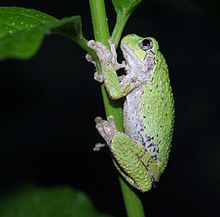- Gray tree frog
-
Gray Treefrog 
Gray Treefrog, Hyla versicolor Conservation status Scientific classification Kingdom: Animalia Phylum: Chordata Class: Amphibia Order: Anura Family: Hylidae Genus: Hyla Species: H. versicolor Binomial name Hyla versicolor
LeConte, 1825The Gray Treefrog (Hyla versicolor) or Gray Tree Frog, is a species of small arboreal frog native to much of the eastern United States and southeastern Canada.[2]
It is sometimes referred to as the Eastern Gray Treefrog, Common Gray Treefrog, or Tetraploid Gray Treefrog to distinguish it from its more southern genetically disparate cousin, the Cope's Gray Treefrog (Hyla chrysoscelis). It may sometimes be referred to as the North American Tree Frog by Europeans to distinguish it from their European Tree Frog (Hyla arborea).
Contents
Physical description
As the scientific name implies, Gray treefrogs are variable in color owing to their ability to camouflage themselves from gray to green, depending on the substrate they are sitting on. The degree of mottling varies. They can change from nearly black to nearly white. They change color at a slower rate than a chameleon. Dead Gray Treefrogs and ones in unnatural surroundings are predominantly gray. They are relatively small compared to other North American frog species, typically attaining no more than 1.5 to 2 in (3.8 to 5.1 cm). Their skin has a lumpy texture to it, giving them a warty appearance. They are virtually indistinguishable from the Cope's Gray Tree Frog, Hyla chrysoscelis, the only readily noticeable difference being their calls. Cope's Gray Tree Frog has a shorter, faster call.[3] The Gray Treefrog also has an extra set of chromosomes (4N), or 48 in total, and is called Tetraploid Gray Treefrog in scientific circles. The more southerly Cope's Gray Treefrog, or Diploid Gray Treefrog, retained its 2N (24) original chromosome set, so hybridization between these species would not be successful.
Both Hyla chrysoscelis and Hyla versicolor have bright yellow patches on the hind legs, which distinguishes them from other treefrogs, such as Hyla avivoca.[4] The bright patches are normally only visible while the frog is jumping. Both species of Gray Treefrogs are slightly sexually dimorphic. Males have black or gray throats, while the throat of the female is lighter.[5]
Tadpoles have a rounded body (as opposed to the more elongated bodies of stream species) with a high, wide tail that can be colored red if predators are in the system. Metamorphosis can occur in as little as 2 months with optimal conditions. At metamorphosis, the new froglets will almost always turn green for a day or two before changing to the more common gray. Young frogs will also sometimes maintain a light green color and turn gray or darker green after reaching adulthood.
Gender identification
The female does not croak and has a white throat. The male does croak and has a black/gray throat. And, the female is usually larger than the male.
Mating
Geographic range
Gray Treefrogs inhabit a wide range, and can be found in most of the eastern half of the United States, as far west as central Texas. They also range into Canada in the provinces of Quebec,[6] Ontario, and Manitoba, with an isolated population in New Brunswick.
The Gray Treefrog is capable of surviving temperatures as low as –8°C.[7]
Habitat
The grey tree frog is most common in forested areas, as it is highly arboreal. Their calls are often heard in rural residential areas of the east coast.
Behavior
These frogs rarely ever descend from high treetops except for breeding. They are strictly nocturnal. Male grey tree frogs rarely have large choruses as they are mostly solitary animals, but might vocalize competitively at the height of breeding periods.
See also
- Cope's Gray Tree Frog, Hyla chrysoscelis
Footnotes
- ^ Hammerson (2004). Hyla versicolor. 2006. IUCN Red List of Threatened Species. IUCN 2006. www.iucnredlist.org. Retrieved on 12 May 2006. Database entry includes a range map and justification for why this species is of least concern.
- ^ NatureServe 'Hyla versicolor'
- ^ Carl Gerhardt and John A. Doherty (1988). "Acoustic communication in the gray treefrog, 'Hyla versicolor': evolutionary and neurobiological implications". J. Comp. Physiol. A 162 (2): 261–278. doi:10.1007/BF00606090. http://www.springerlink.com/content/n7216jh0285155w2/.
- ^ Bernard S. Martof et al. (1980). "Amphibians and Reptiles of the Carolinas and Virginia". Chapel Hill: University of North Carolina Press. ISBN 0-8078-4252-4.
- ^ Thomas F. Tyning (1990). A Guide to Amphibians and Reptiles. Boston: Little, Brown and Company. ISBN 0-316-81719-8.
- ^ Quebec range map, Quebec Biodiversity website
- ^ Adaptations of Frogs to Survive Freezing
References
- Herps of Texas: Gray Treefrog
- Animal Diversity Web: Hyla versicolor
- Pnas.org
- Amphibiaweb.org
- Mindspring.com
External links
- Gray Treefrog - Hyla versicolor Species account from the Iowa Reptile and Amphibian Field Guide
- Gray Treefrog - Hyla versicolor - audio recording of call
- Hyla versicolor LeConte, 1825 at the Encyclopedia of Life
- Tetraploid Gray Treefrog (Hyla versicolor), Natural Resources Canada
- Northern gray tree frog New Jersey Pinelands flora,fauna,and landscapes photo galleries link to northern gray tree frog photograph
Categories:- IUCN Red List least concern species
- Amphibians of Canada
- Amphibians of the United States
- Hyla
- Cryozoa
- Fauna of the Eastern United States
- Fauna of Canada
- Fauna of the Northeastern United States
- Fauna of the Plains-Midwest (United States)
Wikimedia Foundation. 2010.



